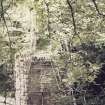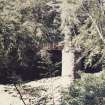Loups Bridge
Suspension Bridge (19th Century)
Site Name Loups Bridge
Classification Suspension Bridge (19th Century)
Alternative Name(s) Layes Suspension Bridge; Loops Bridge; Loups Suspension Bridge; River North Esk; Loups Of Gannochy
Canmore ID 171076
Site Number NO57SE 87
NGR NO 59458 71716
Datum OSGB36 - NGR
Permalink http://canmore.org.uk/site/171076
- Council Aberdeenshire
- Parish Fettercairn
- Former Region Grampian
- Former District Kincardine And Deeside
- Former County Kincardineshire
NO57SE 87 59462 71716
For house of The Burn (NO 5979 7265), see NO57SE 77.00.
Loups Bridge
(disused suspension) [NAT]
OS 1:10,000 map, 1976.
This bridge carries a path over the River North Esk, which here forms the boundary between the the parishes of Edzell (Angus) and Fettercairn (Kincardineshire).
Information from RCAHMS (RJCM), 20 October 2000.
This double span, wrought-iron suspension bridge has a middle masonry pier. Purportedly by John and James Justice of Dundee, the bridge is undated but due to stylistic similarities and differences (pylon masthead similarities, bolt details, blacksmithing technique, stay and wire connections and so on) between known Justice bridges at Glenisla, Angus (NO26SW 8) and Haughs of Drimmie, Perthshire (NO15SE 45), it may date from between 1824 and 1830.
Information (verbal) from Peter Verity, author of Early Iron Suspension Bridges in Scotland, 16 April 2009.
This bridge was visited by RCAHMS as it is under long term threat (it is disused and not maintained) and is a rare survival. The comparison between detailed RCAHMS drawings of Glenisla, Angus (NO26SW 8) and Haughs of Drimmie, Perthshire (NO15SE 45) indeed suggest a strong resemblence between these bridges and The Loups bridge. The W span is approximately 9.01m and the E span is approximately 10.08m in length. The first edition of the Ordnance Survey 25-inch map (Kincardineshire, 1864) shows the bridge in use.
Information from RCAHMS (MMD), 24 April 2009.
Field Visit (15 February 2012)
Loups Bridge, Edzell, Angus
NO 57SE 87 (see DC 51365 and DC51366)
This light, double-span, wrought-iron suspension footbridge with a timber deck (now gone) crosses the River North Esk some 2.9km north north west of Edzell. It is depicted and named ‘Loups Bridge (Suspension)’ on the Ordnance Survey 1st edition 6-inch map (Forfarshire, 1865-8, sheet XX). It has an overall span of 32.4m, the west span being 17.4m and the east, 15.0m. The deck is 1.95m (6 feet 5 inches) in width. There are three inclined stays extending from the simple portals to the deck. One back-stay on either side of the portals anchors the system to the rock. The handrail is anchored by means of an inverted ‘V’ upright in box section, 0.1m (4 inches) in width and a stay. The main north east stay/chain is missing.
There are various elements of this bridge that are similar in part to others known by the blacksmiths Justice and Co. of Dundee, particularly the Haughs of Drimmie, Perthshire (NO15SE 45, c.1830, single-span private road bridge) and Kirkton of Glenisla, Angus (NO26SW 8, 1824, single-span public footbridge). There are similarities in the portal pylon construction in the use of the clamp end of the main bridge anchor; 0.075m (3 inches) square pylon mast or straining post with integral lug and eye piece to receive eye bolt which attaches to the straining wire; dimensions and style of the anchor stays; style of the eye-bolts, check nuts and use of iron cotter pins; the similarities in the use of eye clips and cotter pins on the handrail arrangement ; the use of a scrolled truss at either side of each straining post at each portal and the boom and deck cross-stiffener connections, amongst others.
Its central abutment has loose masonry which in turn is undermining the portal connecting both spans. The slender central portal is 1.7m in height and has two flanking ogee-shaped frames to which the stay cables are anchored. Each of these also has a stiffening ‘Y’ shaped brace, the portal ‘arch’ being attached directly to the frame as well as having its own stays anchoring it to the abutment on its upstream and downstream elevations. The deck under-bracing consists of two struts suspended from the flat, iron stiffener connecting the upstream and downstream handrail uprights. The struts are connected to two tie cables running from the west abutment to the central pier, and from the central pier to the east abutment.
This bridge has been tentatively dated to between 1824 and c.1830 by Mr Peter Verity (see MS6343/6) based on similarities between the Kirkton of Glenisla and the Haughs of Drimmie bridge examples. Loups Bridge is in a poor state of repair and is ‘B’ listed. The site was visited as it is a structure under threat.
Visited by RCAHMS (MMD), April 2009.
Publication Account (2013)
Take public footpath from lay-by just inside Kincardineshire/ Aberdeenshire through the designed landscape of The Burn, Kincardineshire. An intermediate stone pier carries a wrought iron pylon from which splay two sets of three chain-stays to each side. This looks to be 1820s and in the style of John Justice of Dundee (see AN1, Kirkton of Glenisla and Haughs of Drimmie bridges, Perthshire). Without decks it is no longer passable to Angus.
M Watson, 2013






























































































